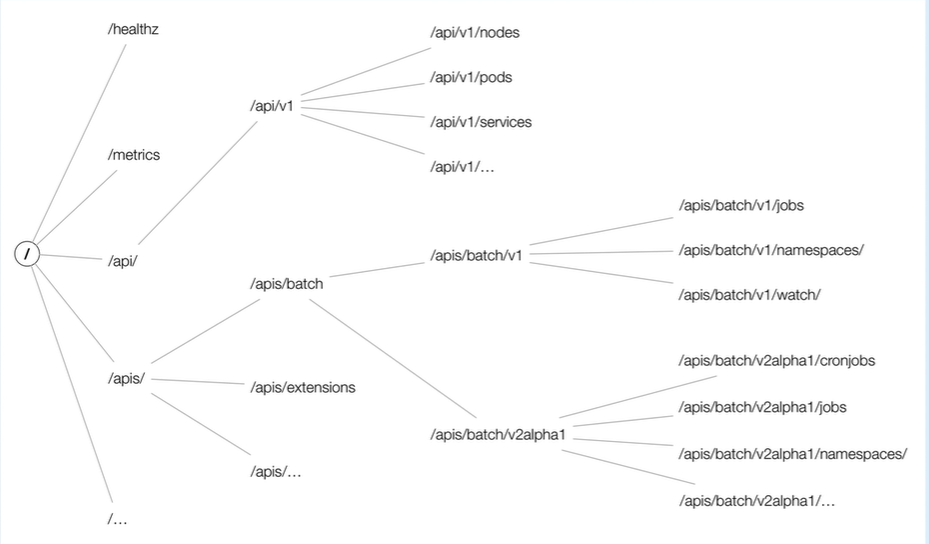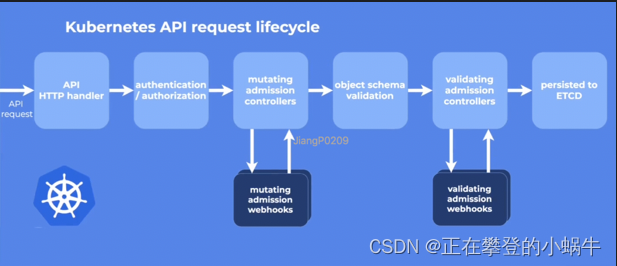一、K8S的api概览:
在Kubernetes集群中,一个API对象在Etcd里完整资源路径,是由:Group(API组)、Version(API版本)和Resource(API资源类型)三个部分组成的。通过这样的结构,整个
Kubernetes里的所有API对象,实际上就可以用如下的树形结构表示出来

我们也可以用命令来查看API组织形式
~ kubectl get --raw /
{
"paths": [
"/api",
"/api/v1",
"/apis",
"/apis/",
"/apis/admissionregistration.k8s.io",
"/apis/admissionregistration.k8s.io/v1",
"/apis/admissionregistration.k8s.io/v1beta1",
"/apis/apiextensions.k8s.io",
"/apis/apiextensions.k8s.io/v1",
"/apis/apiextensions.k8s.io/v1beta1",
"/apis/apiregistration.k8s.io",
"/apis/apiregistration.k8s.io/v1",
"/apis/apiregistration.k8s.io/v1beta1",
"/apis/apps",
"/apis/apps/v1",
"/apis/authentication.k8s.io",
"/apis/authentication.k8s.io/v1",
"/apis/authentication.k8s.io/v1beta1",
"/apis/authorization.k8s.io",
"/apis/authorization.k8s.io/v1",
"/apis/authorization.k8s.io/v1beta1",
"/apis/autoscaling",
"/apis/autoscaling/v1",
"/apis/autoscaling/v2beta1",
"/apis/autoscaling/v2beta2",
"/apis/batch",
"/apis/batch/v1",
"/apis/batch/v1beta1",
"/apis/certificates.k8s.io",
"/apis/certificates.k8s.io/v1",
"/apis/certificates.k8s.io/v1beta1",
"/apis/coordination.k8s.io",
"/apis/coordination.k8s.io/v1",
"/apis/coordination.k8s.io/v1beta1",
"/apis/crd.projectcalico.org",
"/apis/crd.projectcalico.org/v1",
"/apis/discovery.k8s.io",
"/apis/discovery.k8s.io/v1beta1",
"/apis/events.k8s.io",
"/apis/events.k8s.io/v1",
"/apis/events.k8s.io/v1beta1",
"/apis/extensions",
"/apis/extensions/v1beta1",
"/apis/networking.k8s.io",
"/apis/networking.k8s.io/v1",
"/apis/networking.k8s.io/v1beta1",
"/apis/node.k8s.io",
"/apis/node.k8s.io/v1beta1",
"/apis/policy",
"/apis/policy/v1beta1",
"/apis/rbac.authorization.k8s.io",
"/apis/rbac.authorization.k8s.io/v1",
"/apis/rbac.authorization.k8s.io/v1beta1",
"/apis/scheduling.k8s.io",
"/apis/scheduling.k8s.io/v1",
"/apis/scheduling.k8s.io/v1beta1",
"/apis/storage.k8s.io",
"/apis/storage.k8s.io/v1",
"/apis/storage.k8s.io/v1beta1",
"/healthz",
"/healthz/autoregister-completion",
"/healthz/etcd",
"/healthz/log",
"/healthz/ping",
"/healthz/poststarthook/aggregator-reload-proxy-client-cert",
"/healthz/poststarthook/apiservice-openapi-controller",
"/healthz/poststarthook/apiservice-registration-controller",
"/healthz/poststarthook/apiservice-status-available-controller",
"/healthz/poststarthook/bootstrap-controller",
"/healthz/poststarthook/crd-informer-synced",
"/healthz/poststarthook/generic-apiserver-start-informers",
"/healthz/poststarthook/kube-apiserver-autoregistration",
"/healthz/poststarthook/rbac/bootstrap-roles",
"/healthz/poststarthook/scheduling/bootstrap-system-priority-classes",
"/healthz/poststarthook/start-apiextensions-controllers",
"/healthz/poststarthook/start-apiextensions-informers",
"/healthz/poststarthook/start-cluster-authentication-info-controller",
"/healthz/poststarthook/start-kube-aggregator-informers",
"/healthz/poststarthook/start-kube-apiserver-admission-initializer",
"/livez",
"/livez/autoregister-completion",
"/livez/etcd",
"/livez/log",
"/livez/ping",
"/livez/poststarthook/aggregator-reload-proxy-client-cert",
"/livez/poststarthook/apiservice-openapi-controller",
"/livez/poststarthook/apiservice-registration-controller",
"/livez/poststarthook/apiservice-status-available-controller",
"/livez/poststarthook/bootstrap-controller",
"/livez/poststarthook/crd-informer-synced",
"/livez/poststarthook/generic-apiserver-start-informers",
"/livez/poststarthook/kube-apiserver-autoregistration",
"/livez/poststarthook/rbac/bootstrap-roles",
"/livez/poststarthook/scheduling/bootstrap-system-priority-classes",
"/livez/poststarthook/start-apiextensions-controllers",
"/livez/poststarthook/start-apiextensions-informers",
"/livez/poststarthook/start-cluster-authentication-info-controller",
"/livez/poststarthook/start-kube-aggregator-informers",
"/livez/poststarthook/start-kube-apiserver-admission-initializer",
"/logs",
"/metrics",
"/openapi/v2",
"/readyz",
"/readyz/autoregister-completion",
"/readyz/etcd",
"/readyz/informer-sync",
"/readyz/log",
"/readyz/ping",
"/readyz/poststarthook/aggregator-reload-proxy-client-cert",
"/readyz/poststarthook/apiservice-openapi-controller",
"/readyz/poststarthook/apiservice-registration-controller",
"/readyz/poststarthook/apiservice-status-available-controller",
"/readyz/poststarthook/bootstrap-controller",
"/readyz/poststarthook/crd-informer-synced",
"/readyz/poststarthook/generic-apiserver-start-informers",
"/readyz/poststarthook/kube-apiserver-autoregistration",
"/readyz/poststarthook/rbac/bootstrap-roles",
"/readyz/poststarthook/scheduling/bootstrap-system-priority-classes",
"/readyz/poststarthook/start-apiextensions-controllers",
"/readyz/poststarthook/start-apiextensions-informers",
"/readyz/poststarthook/start-cluster-authentication-info-controller",
"/readyz/poststarthook/start-kube-aggregator-informers",
"/readyz/poststarthook/start-kube-apiserver-admission-initializer",
"/readyz/shutdown",
"/version"
]
}%
如:查看批处理操作
[root@master1 ~]# kubectl get --raw /apis/batch/v1 | python -m json.tool
{
"apiVersion": "v1",
"groupVersion": "batch/v1",
"kind": "APIResourceList",
"resources": [
{
"categories": [
"all"
],
"kind": "CronJob",
"name": "cronjobs",
"namespaced": true,
"shortNames": [
"cj"
],
"singularName": "",
"storageVersionHash": "h/JlFAZkyyY=",
"verbs": [
"create",
"delete",
"deletecollection",
"get",
"list",
"patch",
"update",
"watch"
]
},
{
"kind": "CronJob",
"name": "cronjobs/status",
"namespaced": true,
"singularName": "",
"verbs": [
"get",
"patch",
"update"
]
},
{
"categories": [
"all"
],
"kind": "Job",
"name": "jobs",
"namespaced": true,
"singularName": "",
"storageVersionHash": "mudhfqk/qZY=",
"verbs": [
"create",
"delete",
"deletecollection",
"get",
"list",
"patch",
二、YAML书写
通常,kubernetes API支持函通过标准HTTP POST、PUT、DELETE和GET在指定PATH路径上创建、更新 、删除和检索操作,并使用JSON作为默认的数据交互格式。
比如现在我们要创建一个Job对象,那么我们的YAML文件的声明就需要怎么写
apiVersion: batch/v1 kind: Job metadata: name: demo namespace: default
其中Job就是这个API对象的资源类型Kind,而资源类型Resource通常为Kind的小写复数词,比如这里就是jobs,batch就是它的组(Group),v1就是它的版本(Version),APIGroup、Version和资源就唯一定义了一个HTTP路径,
然后kube-apiserver端对这个URL进行了监听,然后把对应的请求传递给了对应的控制器进行处理而已

Resources和Kind的区别是什么?需要注意的是Resources指的是HTTP Restful API请求路径中的资源(理解Restful API的资源),而kind对应的是系统中真正的实体,这两个是有本质区别的。
每个kind都存在于一个Group和Version中,并通过GroupVersionKind(GVK)来标识,GVR和GVK是相关联的,GVK通过GVR标识的HTTP路径来提供服务,将GVK映射到GVR的过程就叫做Rest mapping
三、api请求流程

1、HTTP请求先由DefaultBuildHandlerChain()注册的一系列过滤器处理,这个函数位于k8s.io/apiserver/pkg/server/config.go文件中,它对请求进行一系列过滤操作,经过验证的就返回相应的HTTP返回码
2、接下来根据请求的路径,通过handler路由到各种处理程序中k8s.io/apiserver/pkg/server/handler.go
3、每个API Group都注册了一个handler,详情参见k8s.io/apiserver/pkg/endpoints/groupversion.go和k8s.io/apiserver/pkg/endpoints/installer.go它接受HTTP请求和上下文,并从e处链接及本声明。
原文链接:https://blog.csdn.net/qq_21127151/article/details/124854845